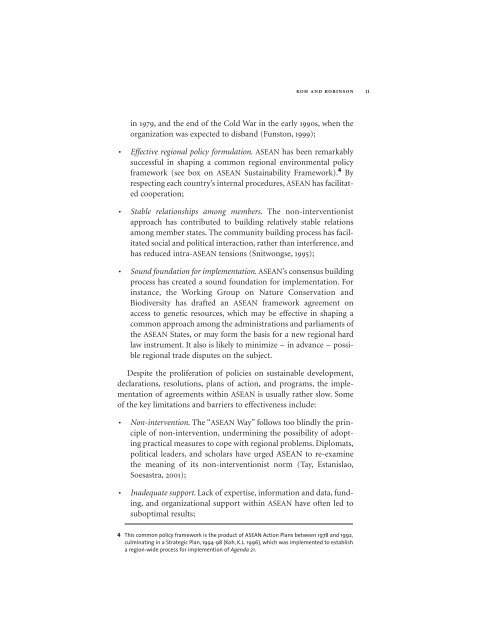Regional Environmental Governance: Examining ... - Yale University
Regional Environmental Governance: Examining ... - Yale University
Regional Environmental Governance: Examining ... - Yale University
You also want an ePaper? Increase the reach of your titles
YUMPU automatically turns print PDFs into web optimized ePapers that Google loves.
KOH AND ROBINSON 11<br />
in 1979, and the end of the Cold War in the early 1990s, when the<br />
organization was expected to disband (Funston, 1999);<br />
• Effective regional policy formulation. ASEAN has been remarkably<br />
successful in shaping a common regional environmental policy<br />
framework (see box on ASEAN Sustainability Framework). 4 By<br />
respecting each country’s internal procedures, ASEAN has facilitated<br />
cooperation;<br />
•<br />
Stable relationships among members. The non-interventionist<br />
approach has contributed to building relatively stable relations<br />
among member states. The community building process has facilitated<br />
social and political interaction, rather than interference, and<br />
has reduced intra-ASEAN tensions (Snitwongse, 1995);<br />
• Sound foundation for implementation. ASEAN’s consensus building<br />
process has created a sound foundation for implementation. For<br />
instance, the Working Group on Nature Conservation and<br />
Biodiversity has drafted an ASEAN framework agreement on<br />
access to genetic resources, which may be effective in shaping a<br />
common approach among the administrations and parliaments of<br />
the ASEAN States, or may form the basis for a new regional hard<br />
law instrument. It also is likely to minimize – in advance – possible<br />
regional trade disputes on the subject.<br />
Despite the proliferation of policies on sustainable development,<br />
declarations, resolutions, plans of action, and programs, the implementation<br />
of agreements within ASEAN is usually rather slow. Some<br />
of the key limitations and barriers to effectiveness include:<br />
• Non-intervention. The “ASEAN Way” follows too blindly the principle<br />
of non-intervention, undermining the possibility of adopting<br />
practical measures to cope with regional problems. Diplomats,<br />
political leaders, and scholars have urged ASEAN to re-examine<br />
the meaning of its non-interventionist norm (Tay, Estanislao,<br />
Soesastra, 2001);<br />
•<br />
Inadequate support. Lack of expertise, information and data, funding,<br />
and organizational support within ASEAN have often led to<br />
suboptimal results;<br />
4 This common policy framework is the product of ASEAN Action Plans between 1978 and 1992,<br />
culminating in a Strategic Plan, 1994-98 (Koh, K.L. 1996), which was implemented to establish<br />
a region-wide process for implemention of Agenda 21.
















